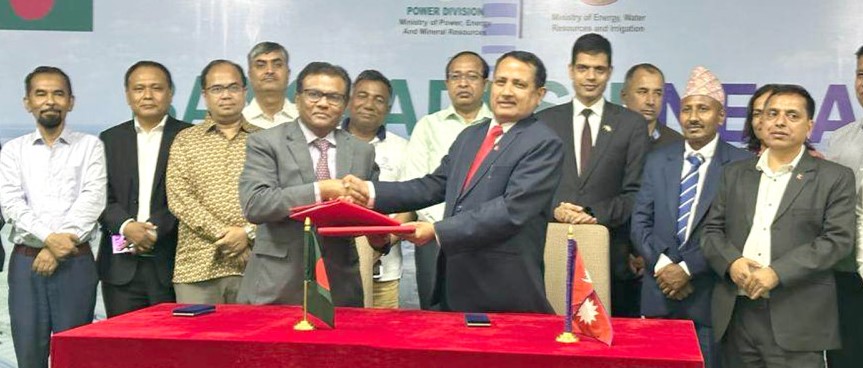KATHMANDU: Bangladesh is prepared to buy electricity from Nepal, which is more plentiful during the rainy season, through India, and has been ready to do so for two years. Using the Indian transmission line is required for this. It was decided to convince India to provide 40 to 50 megawatts of electricity in the first phase during the Nepal-Bangladesh secretary-level meeting that was held on Monday and Tuesday in Bangladesh.
“It has been decided to invite India for a tripartite meeting to discuss the use of Indian transmission lines,” said Kul Man Ghising, Executive Director of Nepal Electricity Authority, who attended the meeting. He stated that there had been discussions about building a specific transmission line to handle future increases in electricity business. Dinesh Kumar Ghimire, secretary of the Nepalese Ministry of Energy, Water Resources and Irrigation, presided over the secretary-level meeting.
The decision to hold a tripartite meeting to foster the trade of electricity was made during the meeting that took place two years ago. The tripartite meeting has not taken place since that time. During the two-day meeting in Bangladesh, it was also discussed how to establish a unique Nepal-India-Bangladesh tripartite mechanism for the trade of electricity from Nepal.
40–50 megawatts of electricity will be exported from Nepal to Bangladesh via Indian territory, according to Prabal Adhikari, Director of the Electricity Trading Department of the Nepal Electricity Authority, who attended the meeting.
Power trading will begin during the following wet season. According to the official, the authority, Bangladesh Power Development Board (BPDP), and the Government of India’s Electricity Trading Corporation met to discuss this and decided to quickly finalize the tripartite agreement.
The construction of a specific transmission line for the exchange of electricity between Nepal and Bangladesh has also been discussed. There has been an agreement to convince India to attend a tripartite meeting because their support and consent are required for this.
The construction of a dedicated electricity transmission line between Nepal and Bangladesh was also decided upon earlier at the Kathmandu meeting. Additionally, it was decided to start a tripartite agreement with India. Last August, a deal was made for 50 MW to be used as a test between Nepal and Bangladesh.
Energy Secretary Ghimire stated that India is hoping to grant permission this time since it has not done so previously and the project’s name was requested for permission during the previous meeting between Nepal and India’s energy secretaries.
Bangladesh also decided during the fourth secretary-level meeting to use India’s infrastructure to purchase 50 megawatts of electricity. It was decided that both sides would try to convince India of this.
At the meeting, it was decided that Bangladesh would purchase 40 to 50 megawatts of electricity from Nepal by October. India has declined, even though it was decided at the meeting to discuss the necessary transformer line for electricity export with India.
Ghimire is hopeful that India will agree because it requested a proposal for a specific project during a meeting between the energy secretaries of Nepal and India in February 2023 and the Nepali side also sent one. After India requested the name of the organization for export to Bangladesh during the February meeting, Nepal put forth a proposal to export the electricity generated by the Likhu-4 hydropower project to Bangladesh.
The resource project was picked and requested after the Indian government said that consent could be granted to use its transmission line for exporting 50 MW of electricity to Bangladesh. The exchange of training and the sharing of experiences are said to have been discussed in addition to this.
During her visit to India in 2022, Bangladeshi Prime Minister Sheikh Hasina asked the country to build a power transmission line so that Bangladesh could import electricity generated in Nepal. The use of Indian land for power transmission was another request she made to her counterpart, Narendra Modi. No progress has been made despite repeated requests from Nepal and Bangladesh for India to trade electricity for land.
Bangladesh will contribute to Sunkoshi 3
It has been decided that the authority and BPDP will jointly develop the 683 MW reservoir Sunkoshi 3 project. The Sunkoshi 3 project will be developed under joint investment within six months via a JV (Joint Venture) agreement, the meeting decided. The decision to ask India for investment, according to Energy Secretary Ghimire, has also been made.
The authority and the Power Development Board of Bangladesh agreed to jointly construct the Sunkoshi 3 project at a meeting on August 8 and 9 of that year in Kathmandu.
In order to discuss the project at the ensuing meeting after the study was finished, it was decided. It was also decided at that meeting that the Nepali side would write the environmental assessment report and the detailed project report.
The authority and BPDP decided during the meeting to form a joint venture company and carry out the project, according to the director. The Koshi Basin Master Plan helped the Japan International Cooperation Agency (JICA) identify the Sunkoshi 3 project, which affects Kavre, Sindhupalchok, and Ramechhap.

